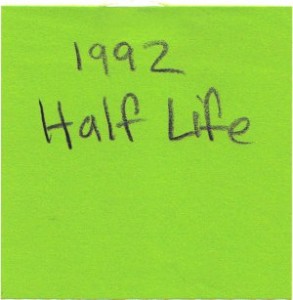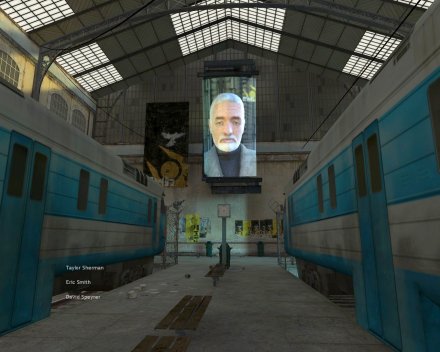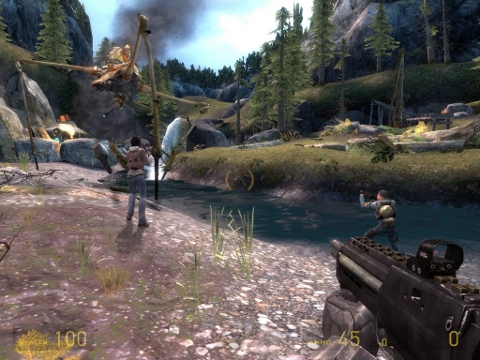Maker Faire 2011 Roundup: Half-Life
Written by ben // August 12, 2011 // Events // No comments
 Most groundbreaking games come from established companies, or, at the very least, established developers. Out of all the games we’ve mentioned so far, only Tetris and Minecraft were a company’s first successful game, and both of those were low-budget games, made by a single independent developer.
Most groundbreaking games come from established companies, or, at the very least, established developers. Out of all the games we’ve mentioned so far, only Tetris and Minecraft were a company’s first successful game, and both of those were low-budget games, made by a single independent developer.
In 1996, Valve Software was founded by Gabe Newell and Mike Harrington. It was funded by their personal savings, which they had accumulated by working at Microsoft. Valve’s first project was Half-Life, an ambitious, high-budget first-person shooter. This story is common in the game development industry. Almost inevitably, it ends with the developers going broke, canceling the game, and leaving the game industry.
 Half-Life was released in 1998 to massive praise. It won over 50 Game of the Year awards from various publications and instantly made Valve a well-known and respected publisher.
Half-Life was released in 1998 to massive praise. It won over 50 Game of the Year awards from various publications and instantly made Valve a well-known and respected publisher.
Most first-person-shooters in 1998 followed a simple formula. You had guns. There were enemies. You traveled through a world filled with enemies, guns, and ammo, picking up the guns and ammo and using them to kill enemies. These games would occasionally switch to a prerecorded non-interactive cutscene, showing a segment of plot, but would then drop the player right back into a simple world filled with bullets and things to use bullets on.
Half-Life had a different strategy. The player keeps control of the protagonist for almost the entire game. Plot was given through in-game scripted events. For example, instead of showing a video of the character walking into a room and talking to scientists, the player would walk into a room, and scientists would talk to you. This improved player immersion dramatically and quickly became an industry standard.
 In addition to being an excellent game in its own right, Half-Life provided an easy framework to make mods. Many of these were developed by fans of the game engine, more were developed in-house and released as standalone projects, and some were developed by fans who were quickly hired by Valve. In addition to two Half-Life expansion packs, the Half-life engine was used to release Team Fortress Classic, Deathmatch Classic, Ricochet, Counter-Strike, and Day of Defeat.
In addition to being an excellent game in its own right, Half-Life provided an easy framework to make mods. Many of these were developed by fans of the game engine, more were developed in-house and released as standalone projects, and some were developed by fans who were quickly hired by Valve. In addition to two Half-Life expansion packs, the Half-life engine was used to release Team Fortress Classic, Deathmatch Classic, Ricochet, Counter-Strike, and Day of Defeat.
In 2004, Valve released its second full-sized game, Half-Life 2. Where Half-Life had innovated, Half-Life 2 expanded and polished. Half-Life 2 took Half-Life’s interactive cutscenes to an extreme, with multiple entire cinematic sequences done entirely within the game engine. The game ended on a cliffhanger and Valve announced that further games in the series would be episodic. Half-Life 2: Episode 1 and Half-Life 2: Episode 2 were released in 2006 and 2007 respectively, further refining the signature Half-Life storytelling mechanics.
 When collating our original votes from Maker Faire, we had to choose whether to consider “Half-Life” and “Portal” to be a single series or two separate series. We decided to separate them due to their vastly different atmosphere. However, Half-Life 2: Episode 3 is known to introduce the Portal world into Half-Life, although the actual mechanics of this are not yet known outside the company.
When collating our original votes from Maker Faire, we had to choose whether to consider “Half-Life” and “Portal” to be a single series or two separate series. We decided to separate them due to their vastly different atmosphere. However, Half-Life 2: Episode 3 is known to introduce the Portal world into Half-Life, although the actual mechanics of this are not yet known outside the company.
Half-Life 2: Episode 3 is in production, although no release date has yet been announced.

